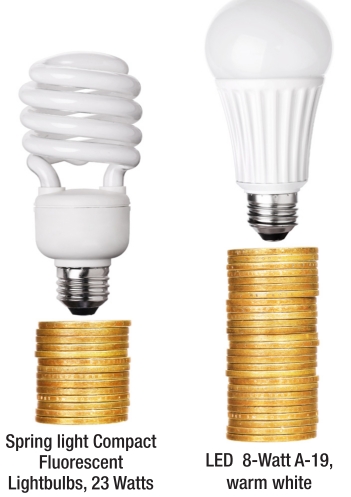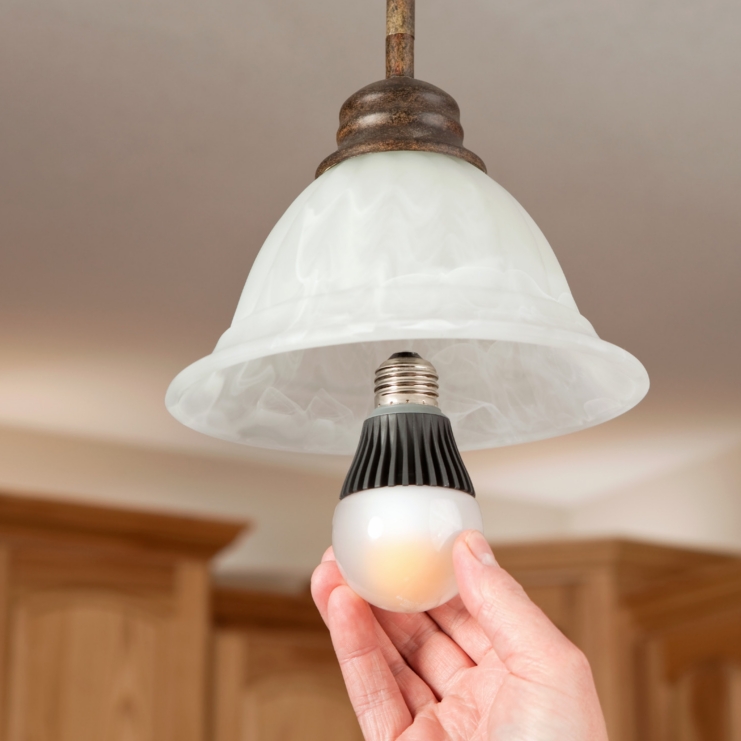save time and energy WITH LEDS

Switching bulbs is a bright idea
When you walk in your pantry, flip the light switch only to find the bulb has burned out, you let out a sigh. Changing out the bulb is yet another item on the seemingly never-ending list of house chores. It’s always one thing after another, right?
What if there were 20 years between the time you screwed in that new bulb and the time it would need to be replaced? Read: 20 years. That would save you quite a few sighs.
One of the advantages of replacing all of your current incandescent or compact florescent lightbulbs (CFLs) with light emitting diodes (LEDs) is the lifespan. In fact, one LED lightbulb lasts longer than two and a half CFLs or up to 25 incandescent bulbs (based on 1,000 hours’ life for incandescents and 10,000 hours for CFLs). To put that in perspective: If you use an incandescent bulb two to three hours a day for 365 days, you’ll get your 1,000 hours in a year’s time. If you use a CFL in the same lamp for two to three hours a day, you’ll replace it in 10 years. If the lamp had an LED bulb that was illuminated two to three hours a day, you’d change that bulb in quite possibly up to 25 years.
Consider this: A woman with a newborn child could install an ENERGY STAR-rated LED bulb and not replace it until said child attends college or even graduates.
If you’re still not convinced to make the switch to LEDs for the mere time savings, consider the pros and cons of different bulbs from the editors of Consumer Reports next time you find yourself overwhelmed with the choices on a lightbulb aisle: Incandescent Pros: They won’t break the bank … initially. The light is warm and displaced equally in the area it is in.
Cons: They will break the bank over time, because you’ll be replacing them every six months to a year.
Plus, they’re hot to the touch and use quite a bit of electricity. In fact, 10 percent of the energy used by the bulb actually illuminates space, while the rest – 90 percent – yields heat. Eliminating excess heat in the Louisiana summer is a no-brainer.
Also worth noting: The Energy Independence and Security Act of 2007 “requires most screw-in light bulbs to use at least 27 percent less energy by 2014,” reported the Pittsburgh Post-Gazette in 2013. “CFLs, LEDs and some halogen bulbs meet that requirement. Standard incandescents do not and are being phased out.”
“I’m not a fan of fluorescent bulbs in all fixtures. As they burn out, I’ve been replacing them with LED bulbs,” said Josie Henderson of Longview, Texas. “My main hesitation to switch at first was price. However, they have come down [in cost] quite a bit. The fact that they use less energy and last so much longer are attractive reasons I buy them. Also, the fluorescent bulbs break, and I’ve been cut by one. So I want them gone ... all of them.”
Compact fluorescent light (CFL) Pros:
CFLs use about 75 percent less energy than the incandescents and last
up to 10 times longer than the original bulb. On average, you’ll recover
the cost of your CFL in under a year.
Cons: It can take a couple minutes for the bulb to reach its full brightness. The majority of these bulbs aren’t dimmable, and they contain mercury. While it’s a small amount, mercury is still toxic to your health and the environment. LED Pros: Where to start? The estimated annual energy cost of a 5.5-watt LED bulb I purchased for indoor or outdoor use is $0.66. This bulb is guaranteed to last 13+ years, according to its packaging. Speaking of packaging, do understand that the wattage has nothing to do with the light output. Wattage is energy use. In the past I know I’ve purchased lights based on “40w” or “60w” when I mistakenly thought this was the amount of light I’d receive from the bulb. The 5.5 bulb I just mentioned is the equivalent to a 40w incandescent. Look for the watt equivalency when searching for an LED. Also look for the ENERGY STAR certification. These two things will ensure you are making the right product choice.
Also worth noting: An LED bulb’s performance is not affected by turning it on and off, and each time it is turned on, the brightness is instant.
Cons: You’ll need to do your homework on which LED bulb is best for the area you’re lighting. I’d add cost, but, honestly, when you compare the cost of an LED over time with the cost of multiple incandescents and/or CFLs, it’s not a disadvantage at all. It’s an investment in energy and time savings.
“I’m moving towards all LEDs, slowly but surely,” said Benjamin Williamson of Shreveport. “Also, I write the date I first use the bulb on it in Sharpie so when it finally burns out I can say, “Sweet! This one lasted 10 years!”
Karen E. Wissing works in Shreveport-Bossier City and loves her community.
E-mail your questions, comments or suggestions to editor@theforumnews.com.

